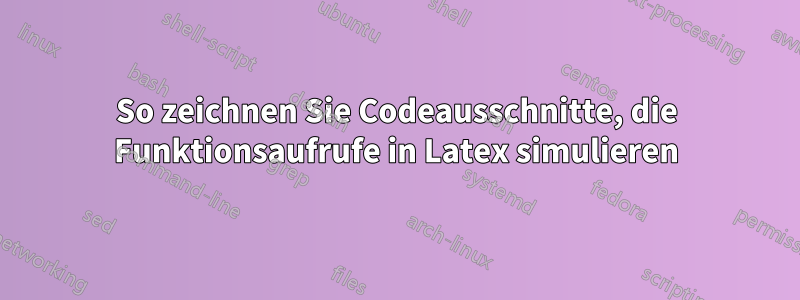
Antwort1
Ein erster kurzer Ansatz (aber ohne listingsPaket):
\documentclass[border=10pt]{standalone}
\usepackage{tikz}
\usetikzlibrary{shadows, shapes.callouts}
\begin{document}
\begin{tikzpicture}[font=\ttfamily]
\foreach \x in {1,...,3} {
\node[fill=white, draw, drop shadow, align=left] at ({0.5*\x},{-0.5*\x}) (box \x) {
string reverseOf(string s) \{ \\
\quad\textcolor{magenta}{if} (s == "") \{ \\
\quad\quad\textcolor{magenta}{return} ""; \\
\quad\} \textcolor{magenta}{else} \{ \\
\quad\quad\textcolor{magenta}{return} reverseOf(s.substr(1)) + s[0]; \\
\quad\} \\
\}
};
\node[shape=rectangle callout, fill=black!10, draw, minimum width=3em, callout relative pointer={(-0.25,-0.25)}] at ([xshift=5pt, yshift=7.5pt]box \x.center) { "" };
\node[fill=black!10, draw=blue, anchor=south east, minimum width=3em, label={180:{string s}}] at ([xshift=-2pt, yshift=2pt]box \x.south east) { "p" };
}
\end{tikzpicture}
\end{document}
Antwort2
In Abhängigkeit von@Jasper Habicht, wir können font verwenden (das mit oder \usepackage{fontspec, inconsolata}kompiliert werden muss ), um es mehr wie einen Code aussehen zu lassen, da wir es nicht in der Schleife verwenden können (zumindest konnte ich das nicht). Die Eingabe und Ausgabe, um es so nah wie möglich an das Bild heranzubringen, sind also:LuaTeXXeLaTeX\verb| |\foreach
\documentclass[border = 1cm, 11pt]{standalone}
\usepackage{tikz}
\usepackage{xcolor}
\usepackage[most]{tcolorbox}
\usepackage{fontspec}
\usetikzlibrary{shapes.callouts, shadows}
\setmonofont{inconsolata}
\begin{document}
\begin{tikzpicture}[font = {\ttfamily}]
\foreach \i in {1,...,4} {
\node[
black,
align=left,
minimum width = 10.5 cm,
minimum height = 4 cm,
draw,
drop shadow={fill=black!100!white,shadow xshift=+2.4mm, shadow yshift=-2.4mm},
line width = 3pt,
fill=white,
inner xsep = 12pt,
] at ({0.7*\i},{-0.8*\i}) (thenode \i){%
string reverseOf(string s) \{ \\
\quad \textcolor{violet}{\textbf{if}} (s == "") \{ \\
\quad\quad\quad \textcolor{violet}{\textbf{return}} ""; \\
\quad \} \textcolor{violet}{\textbf{else}} \{ \\
\quad\quad\quad \textcolor{violet}{\textbf{return}} reverseOf(s.substr(1)) + s[0]; \\
\quad \} \\
\}
};
\node[
fill=blue!5!white,
draw=black,
anchor=south east,
minimum width=4em,
label={180:{string s}}
] at ([xshift=-7pt, yshift=7pt]thenode \i.south east) { "p" };
\node[%
shape=rectangle callout,
fill=black!10!white,
draw= black,
minimum width=5em,
rounded corners,
callout relative pointer={(-0.7,-0.45)}
] at ([xshift=27pt, yshift=9.7pt]thenode \i.center) {""};
}
\end{tikzpicture}
\end{document}





